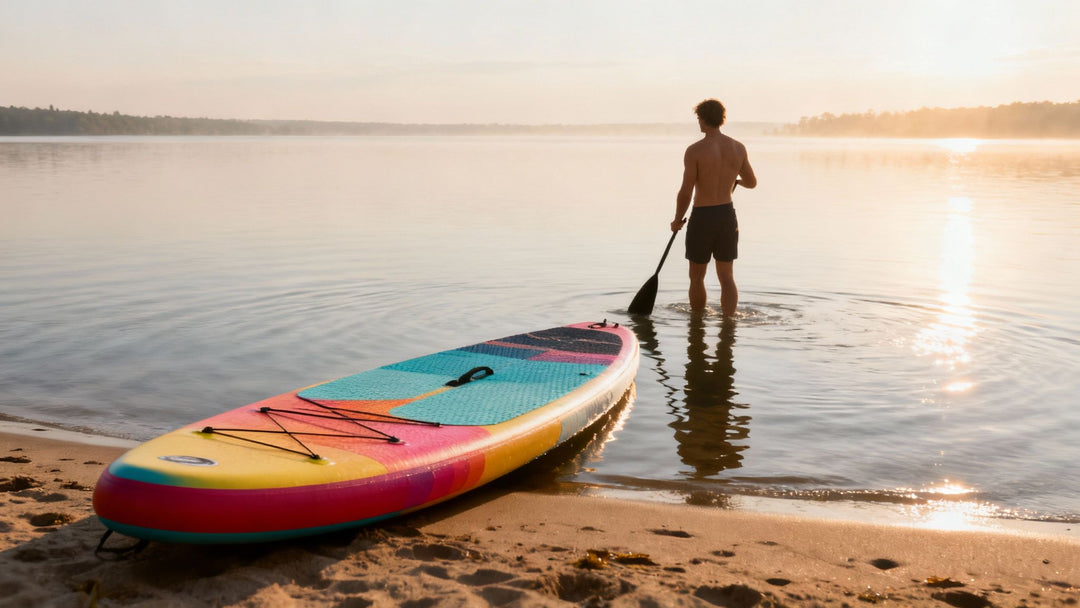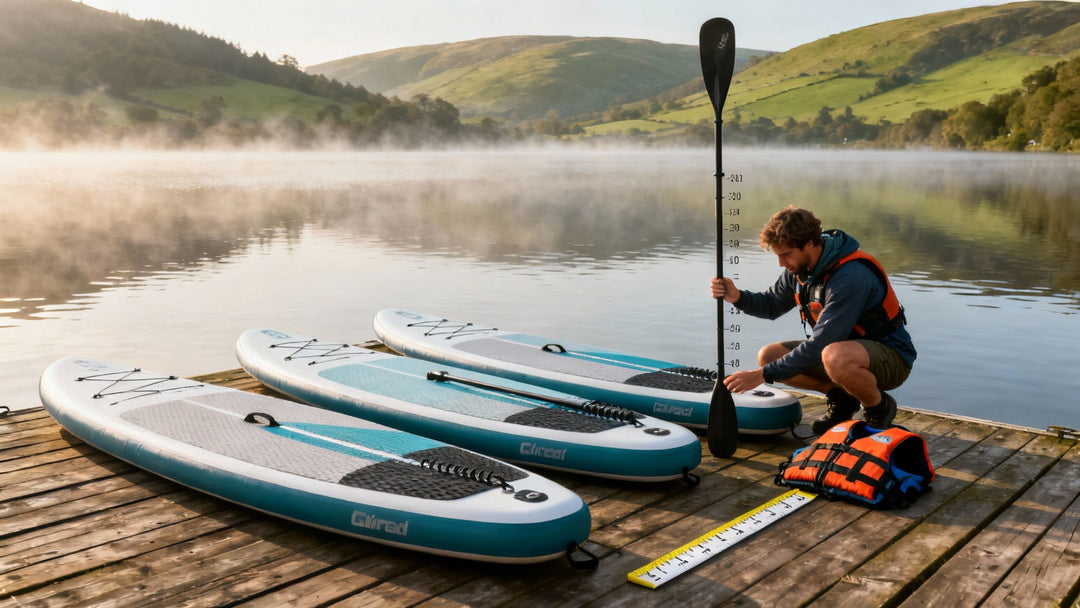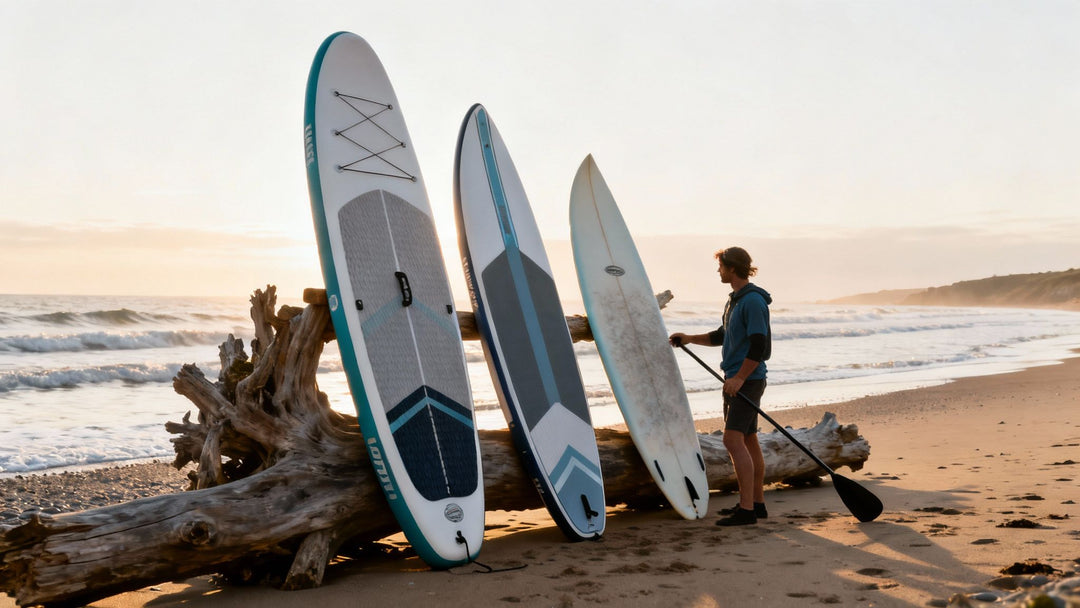Your Guide to Choosing a Beginner Paddle Board
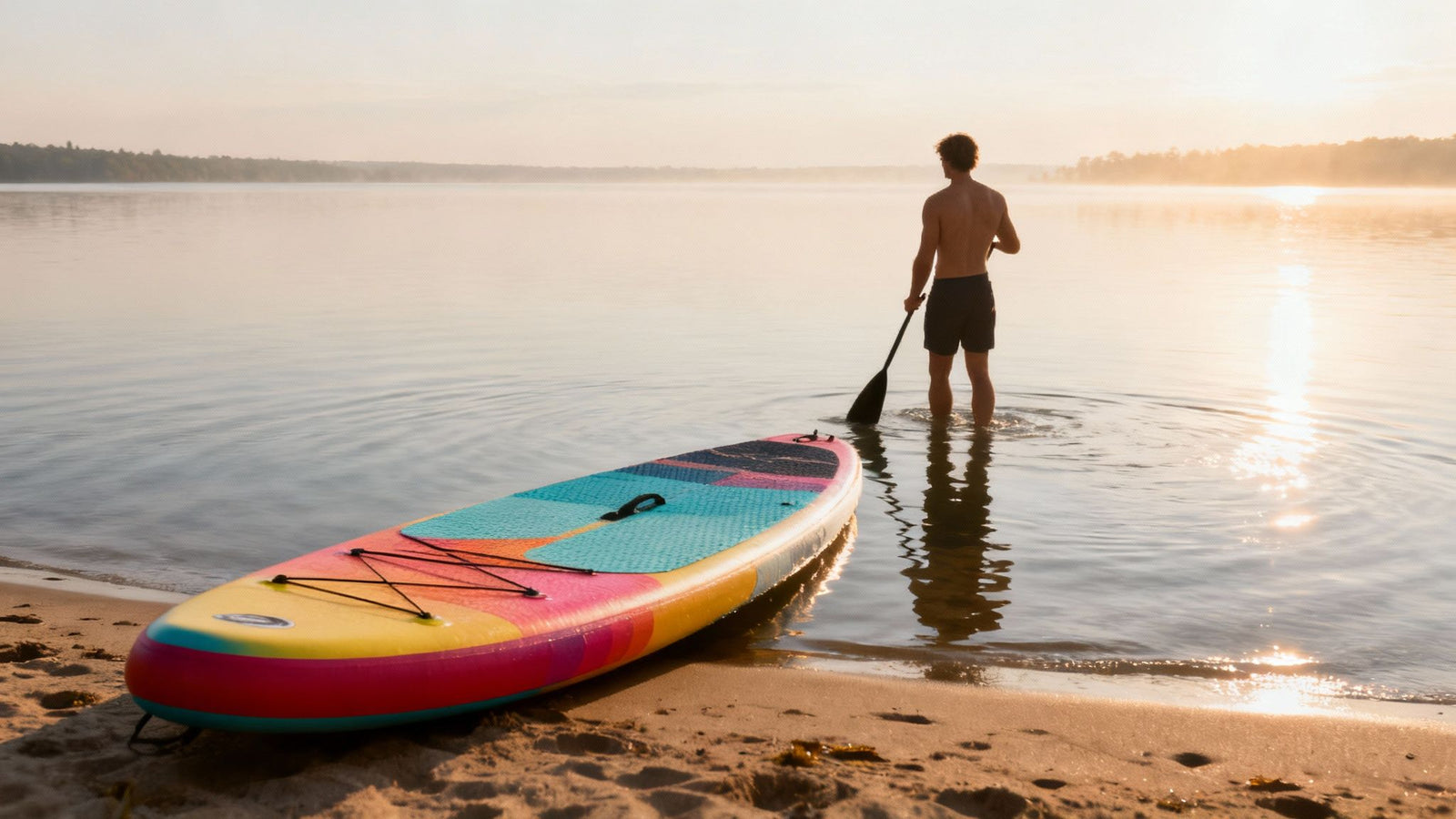
So, you’re thinking about getting into paddle boarding? Fantastic choice. You’re about to join one of the UK's fastest-growing and most rewarding water sports.
If you're wondering where to start, the simple answer for most newcomers is a stable, wide, inflatable stand-up paddle board (iSUP) package. Something like the Loco Amigo Air is a brilliant first board because it gives you that perfect mix of stability, toughness, and portability you need while you're finding your sea legs. For instance, if you're a family looking for a board everyone can use at the local lake, the Amigo Air's all-round shape and durable construction make it an ideal choice. This guide will walk you through everything, so you can start your adventure with confidence.
Your Adventure into Paddle Boarding Starts Here
Welcome to the world of Stand-Up Paddle Boarding (SUP). Let's cut through the jargon. At its heart, paddle boarding is about gliding across a glassy lake as the sun comes up or nosing into a hidden coastal cove on a lazy summer afternoon. It’s about freedom and simple joy, and it’s way easier to get into than you might think.
This guide is your friendly companion, designed to take you from total beginner to a paddler who feels right at home on the water. We’ll break down everything from choosing the right board to what to do on your very first day out. Our mission is to get you started safely and make sure you have an amazing time from the get-go.
Why Paddle Boarding Is for Everyone
One of the best things about SUP is that pretty much anyone can do it. It’s a brilliant low-impact workout that builds your balance, strengthens your core, and gets your heart pumping without hammering your joints. It’s a sport that genuinely spans all ages and fitness levels.
It's completely normal to have a few nerves at first, but there are even great resources for overcoming any initial fear of water so you can fully relax and enjoy yourself.
There’s a reason you’re seeing paddle boards everywhere in the UK. The sport has exploded in popularity, and the numbers back it up. The global SUP market is projected to skyrocket from USD 1.90 billion in 2025 to a massive USD 3.77 billion by 2032. That’s a whole lot of people discovering the magic of being on the water. It really is the perfect time to dive in.
Think of a beginner paddle board as your ticket to exploration. It’s more than just a new hobby; it’s a way to see familiar places from a fresh perspective, connect with nature, and find a bit of peace in a busy world.
To make your journey as smooth as possible, we're sticking to practical, real-world advice. Here’s a sneak peek at what we’ll cover:
- The Right Board: We’ll explain why an inflatable board is almost always the best shout for a beginner.
- Essential Kit: A no-fluff list of what you actually need for your first time out.
- Core Skills: Simple, step-by-step tips to get you standing and paddling like a pro.
- Safety First: How to understand the conditions and stay safe while you’re having fun.
How to Choose Your First Beginner Paddle Board
Picking out your first board is probably the most important decision you'll make on your paddle boarding journey. If you get it right, you're in for more fun, quicker progress, and a much safer time on the water. We're going to break down the essentials so you can choose your first beginner paddle board feeling totally confident.
First up, the big question: inflatable or a solid hard board? For example, if you live in a city flat with limited storage and drive a small car, an inflatable board that packs into a backpack is a practical game-changer. A hard board is your high-performance option—rigid, responsive, and built for maximum performance, but requires a roof rack and storage space. An inflatable stand-up paddle board (iSUP), on the other hand, is versatile, ridiculously convenient, and spot-on for pretty much any casual adventure.
For the vast majority of newcomers, an iSUP is the clear winner. They are incredibly tough, surprisingly rigid when you pump them up properly, and their portability is a complete game-changer. You can roll one up, chuck it in the boot of your car, and go exploring waterways all over the UK without ever needing a roof rack. This sheer convenience is a massive reason the sport has exploded in popularity recently.
This concept map really gets to the heart of why people fall in love with paddle boarding: it's an accessible sport that gives you a unique sense of freedom, all while being a safe activity when you know what you're doing.
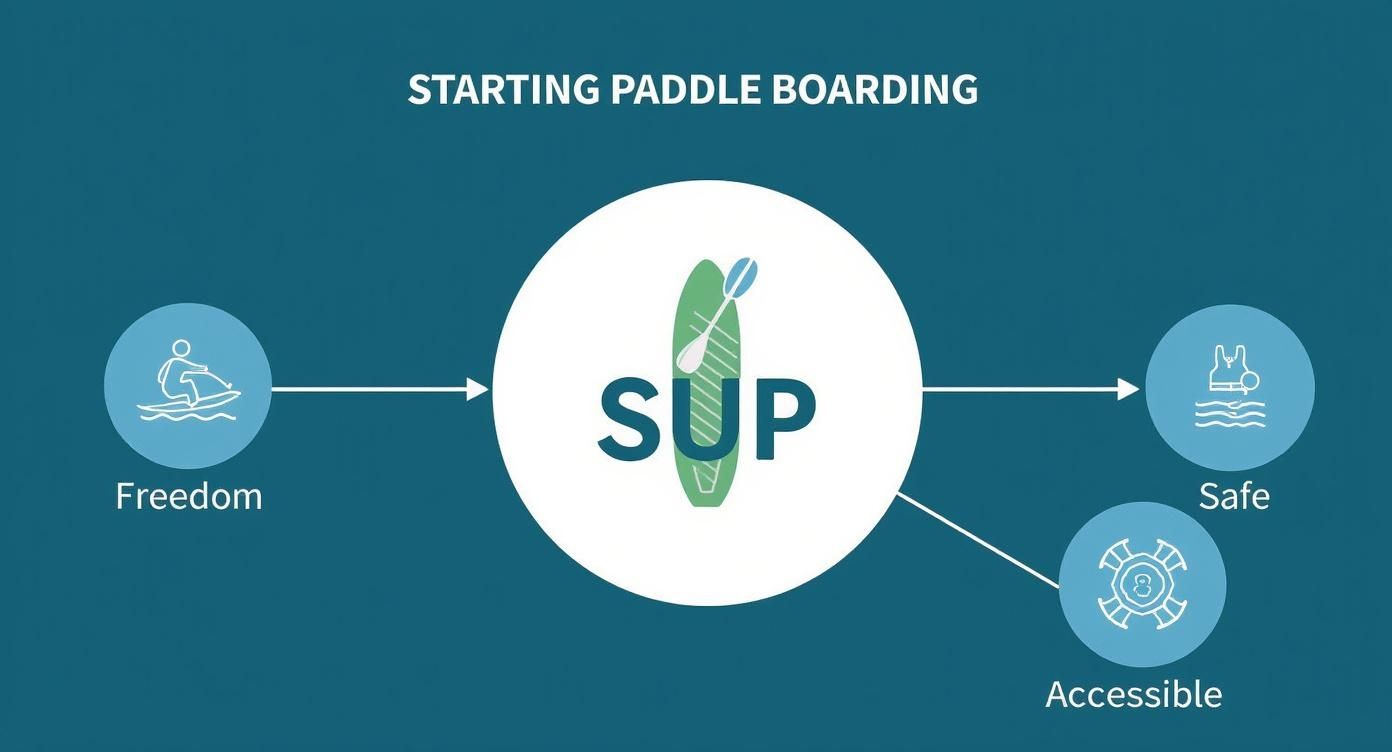
The visual shows exactly why so many people are drawn to SUP. It perfectly blends the thrill of exploration with a really low barrier to entry.
Inflatable vs. Hard Boards: Which Is Right for You?
While you'll see pro racers and surfers on hard boards for their extra speed and precision, an iSUP brings benefits that are far more valuable when you're just starting out. Modern inflatables, like our brilliant Loco Amigo Air, are built with advanced drop-stitch technology. This makes them feel almost as stiff as a solid board but with a slightly more forgiving surface if you take a tumble.
The recent boom in local, outdoor activities has only made iSUPs more appealing. The COVID-19 pandemic, despite causing some initial supply chain headaches, ended up sparking a huge interest in paddle boarding across the UK. As people looked for safe, socially distanced ways to get outside, the stability and pop-it-in-the-car convenience of inflatable boards made them the go-to for thousands of new paddlers. You can find more on this trend in a recent market analysis on businessresearchinsights.com.
Here’s a quick rundown to help you decide:
- Portability: iSUPs win, no contest. They pack down into a backpack, making them dead easy to transport and store.
- Durability: This might surprise you, but iSUPs are exceptionally tough. A practical example is launching from a rocky beach; an iSUP can handle bumps against rocks or being dropped without getting the dings a hard board would.
- Stability: A quality inflatable board offers fantastic stability, which is exactly what you need when you're finding your sea legs.
- Performance: Sure, hard boards offer better glide and speed, but that's a difference a beginner is unlikely to notice or even need.
Understanding Board Dimensions: Length, Width, and Thickness
Once you've settled on an iSUP, the next piece of the puzzle is understanding how a board's dimensions affect how it feels on the water. Three numbers matter most: length, width, and thickness. Getting these right is the secret to stability.
Width is the single most important factor for a beginner. Think of a wider board as having stabilisers on a bike. A board in the 32 to 34-inch range provides a solid, steady platform that makes finding your balance a whole lot easier. For example, the Loco Amigo Air range offers boards in 32" and 34" widths, perfect for building that initial confidence. Go any narrower, and things can start to feel wobbly.
Length affects how the board moves through the water. Longer boards (11 feet and over) tend to be faster and travel in a straighter line, which is great for touring. Shorter boards (under 10 feet) are easier to turn. For a first board, an all-rounder shape somewhere between 10' and 10'8" is the perfect sweet spot.
Thickness, usually 5 or 6 inches for iSUPs, impacts both stiffness and volume. A 6-inch thick board is generally more rigid and can support more weight without bending, which all adds to that feeling of stability.
"Your first board's job is simple: to make you feel safe and stable. Prioritise width and volume over speed. You can't have fun if you're constantly worried about falling in."
This focus on stability is absolutely crucial. A board that feels secure under your feet lets you relax, concentrate on your paddling technique, and actually enjoy the scenery around you.
What Is Board Volume and Why It Matters
Volume, measured in litres, is just a fancy way of talking about a board's ability to float. It tells you how much weight it can support while still performing well. The higher the volume, the more buoyant the board is and the higher it will sit on the water.
For a beginner, more volume is your friend. It directly translates to more stability. Your body weight is the main thing to consider when figuring out how much volume you need. A board without enough volume for your weight will sit too low, feel sluggish, and be incredibly unstable.
This is where checking the manufacturer's recommended weight capacity is vital. For example, if you weigh 85kg and want to take your 20kg dog with you, you need a board with enough volume to support at least 105kg plus gear. For a more detailed look, you can check out our guide on selecting the perfect paddle board size.
A Simple Sizing Guide for Your First Board
Choosing the right dimensions can feel like a lot to take in, but it doesn't have to be. We've put together this simple table to help you match your weight to the ideal all-around board dimensions for maximum stability. Think of it as a great starting point for finding a beginner paddle board that will feel just right.
Beginner Paddle Board Sizing Guide
| Rider Weight (kg) | Recommended Board Length | Recommended Board Width | Example Loco Board |
|---|---|---|---|
| Under 75 kg | 10' - 10'6" | 32" | Loco Amigo Air 10' |
| 75 kg - 95 kg | 10'6" - 10'8" | 32" - 34" | Loco Amigo Air 10'6" |
| Over 95 kg | 10'8" - 11'+ | 34" | Loco Amigo Air 11' |
By focusing on these key ingredients—board type, width, and volume—you are setting yourself up for success from day one. The perfect beginner board is one that feels like a trusted friend out on the water, giving you all the support you need to build your skills and fall in love with the sport.
Essential Gear You Actually Need for Day One
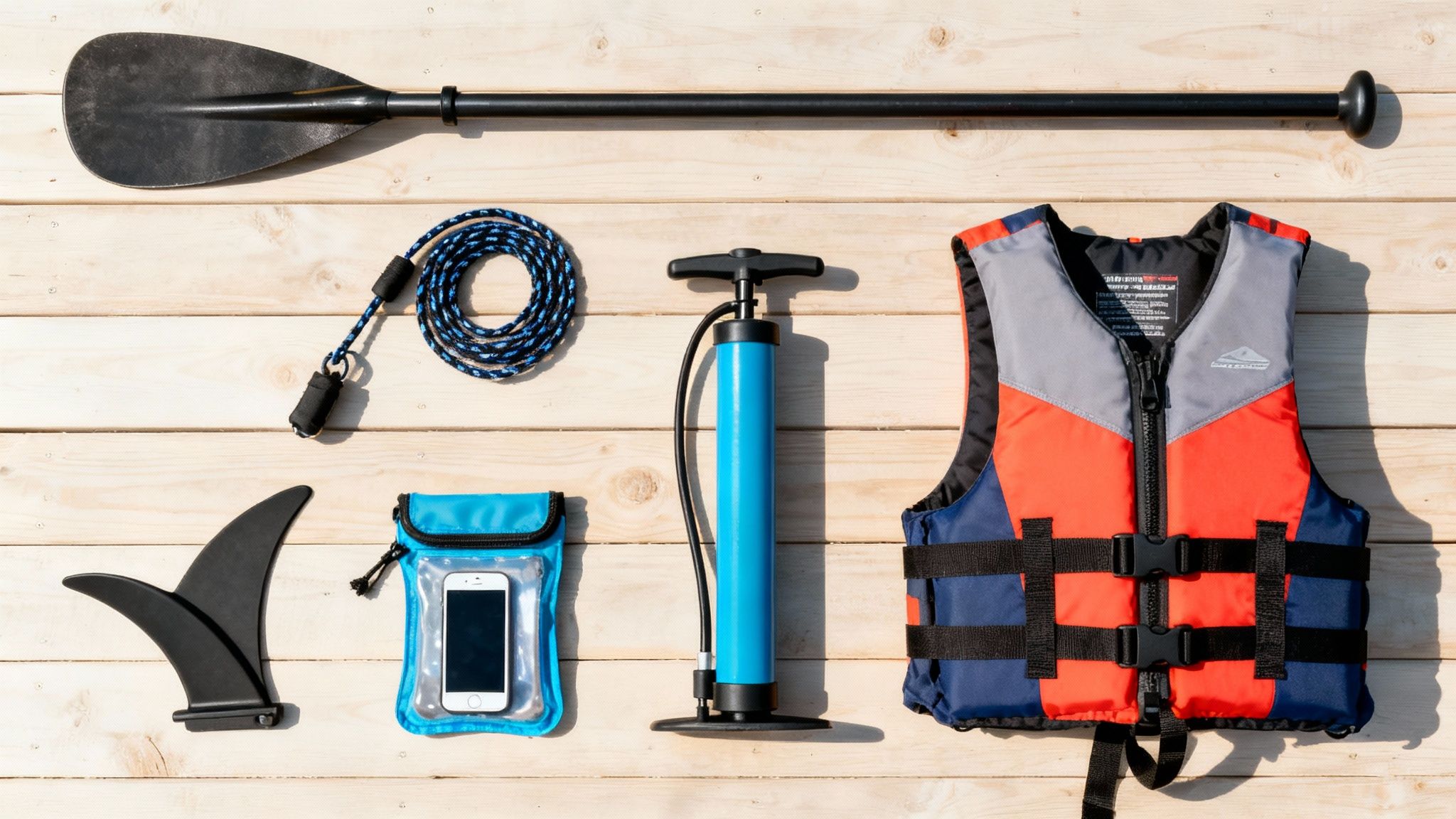
So, you’ve picked out the perfect beginner paddle board. What's next? It's time to get your kit sorted. It’s easy to get carried away with all the shiny accessories out there, but for your first few times on the water, you only really need a few key bits of gear. This isn’t just a shopping list; understanding why each piece is important is your first real step to becoming a safe and confident paddler.
Paddle boarding has absolutely exploded in popularity, and with it, a whole industry of gear has popped up. In fact, stand-up paddleboarding is a huge reason the UK water sports market is booming, and it's expected to hit around USD 126.30 million by 2025. That growth comes from new paddlers like you grabbing the right kit to get started. You can see more on the booming UK water sports market on Statista.
Your Engine: The Paddle
Think of your paddle as your engine – and they’re not all built the same. Most starter packages, like our Loco Amigo Air packages, come with an adjustable hybrid carbon paddle, which is a fantastic lightweight and durable choice to get you going.
Imagine trying to go for a long walk in heavy work boots. That’s an old-style aluminium paddle. A lighter carbon or fibreglass paddle is like slipping on a pair of lightweight trainers. For a practical example, after an hour of paddling, the difference in weight can be the difference between having aching shoulders and feeling fresh enough to keep exploring.
- Aluminium Paddles: They're cheap and tough, but they're also the heaviest and will sink like a stone if you drop them.
- Fibreglass/Carbon Hybrid Paddles: A brilliant middle ground, like the ones in our Loco paddle range. They feel much lighter than aluminium and have a bit of flex, which is kinder on your joints.
- Full Carbon Paddles: The lightest, best-performing option. This is what you upgrade to when you get serious about speed or distance.
For your first board, an adjustable paddle is a must. It lets you dial in the perfect height (aim for 6-8 inches above your head) and means you can share the board with friends and family.
The Most Important Safety Item: Your Leash
If you take away just one piece of safety advice, make it this: always wear your leash. Your leash is the seatbelt of paddle boarding. It’s that simple cord connecting you to your board, and it is, without a doubt, the most critical bit of safety gear you own.
Your board is a giant floatation device. If you fall off, especially when it’s windy or the water's a bit choppy, it can get pushed away from you in seconds. As a practical example, a sudden gust of wind can send your board skating across the water faster than you can swim. The leash is your guarantee that your board—and your ticket back to safety—is always right there with you. Make sure it's fastened securely to your ankle or calf before you even think about getting on the water.
Staying Afloat: Buoyancy Aids
While your board will keep you afloat, a personal flotation device (PFD) or buoyancy aid is your backup. It gives you a massive confidence boost when you’re starting out and is essential if you're not a strong swimmer or are paddling in trickier conditions.
Here in the UK, it’s not always a legal requirement for adults on a SUP, but organisations like the RNLI can't recommend them highly enough. Forget those bulky, orange life jackets from your childhood; modern buoyancy aids are sleek and comfortable. You can get vests that give you total freedom of movement or even discreet waist-packs that inflate if you need them. To get the full picture, read our detailed guide on choosing the right paddle board life jacket.
"A buoyancy aid is peace of mind. You paddle with more confidence knowing you have that extra layer of safety, letting you focus on technique and having fun."
The Steering System: Your Fin
The fin is the unsung hero of your whole setup. It’s that little rudder on the tail that stops your board from wiggling from side to side every time you take a stroke. Without it, you’d just spin in circles.
Most beginner inflatable boards, like our Loco Amigo Air, come with a simple single-fin system. It’s a great setup that gives you excellent tracking (the ability to go straight) and stability without creating much drag. You just slide it in before you inflate the board, and you’re all set for exploring calm lakes, rivers, and coastal spots.
Practical Extras for a Better Day
Finally, there are a few little things that can turn a good day on the water into a great one.
- A Dry Bag: A small waterproof bag is non-negotiable for keeping your keys, phone, and snacks dry. For example, a 5-litre dry bag is perfect for essentials and clips easily under the bungee cords on the nose of your board.
- The Right Clothing: Ditch the cotton. Once it’s wet, it’s cold and heavy. Go for quick-drying sportswear, swimwear, or a wetsuit, depending on how warm the air and water are.
- Your iSUP Pump: Your board will come with a high-pressure pump. Pumping it up to the recommended PSI (usually 15-18) is crucial for performance. A properly inflated board is a rigid, stable board.
Your Step-by-Step Plan for a Successful First Outing
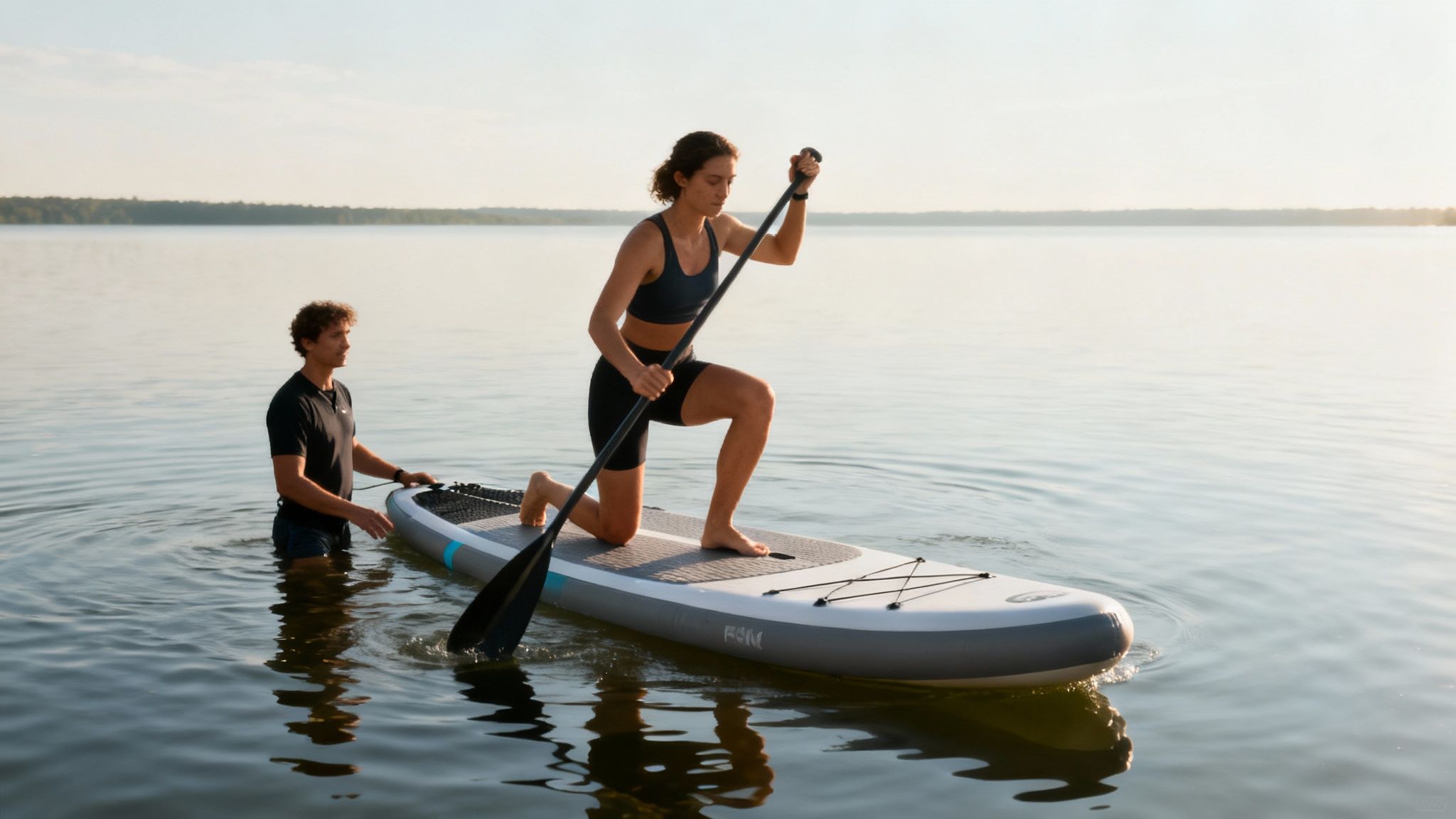
Right, this is it. This is the moment all the theory gets put into practice and you finally get to experience that magic feeling of gliding across the water.
Let's get one thing straight: a successful first time out isn't about standing up perfectly on your first attempt. It's about building confidence, getting a feel for the basics, and, most importantly, having a brilliant time. We'll break it down into simple, easy-to-follow steps to turn any first-time jitters into pure fun.
The secret to a great first session is all in the prep. A little bit of planning before you even shut the front door sets you up for a safe and stress-free adventure on your beginner paddle board. Think of it as your pre-flight check.
Pre-Launch Checks for Safety and Fun
A few quick checks before you get anywhere near the water will make a world of difference. Trust me, rushing this part is a rookie mistake you can easily sidestep.
-
Check the Weather: Your new arch-nemesis is the wind. For your first few paddles, you want a day with barely a breeze – aim for under 10 mph. A reliable source like the Met Office's marine forecast is your best friend here for checking wind speed and, crucially, its direction.
-
Pick Your Spot Wisely: Find a sheltered spot with calm, flat water. For example, a local reservoir like Queen Mother Reservoir in Berkshire or a calm estuary like the River Cuckmere in East Sussex are perfect beginner locations. Steer clear of busy areas with lots of boat traffic.
-
Tell Someone Your Plan: This is non-negotiable. A practical example is sending a simple text: "Hey, I'm going for a paddle at Swan Lake, should be back by 3 pm." It’s a simple safety habit to get into from day one.
Getting on the Water: From Knees to Feet
Your first objective isn't to stand up. It’s simply to get comfortable on the board. The best way to do this is from your knees, which lowers your centre of gravity and makes the board feel much more stable.
Start by walking your board out into knee-deep water – deep enough that the fin isn't scraping along the bottom. Place your paddle flat across the board in front of you and use it for a bit of extra balance as you climb on, one knee at a time. You're aiming to get your knees on either side of the central carry handle.
Now, just take a minute. Get a feel for how the board moves under you. Try a few gentle paddle strokes on each side while you're still kneeling. This is a great way to understand how the board responds before you even think about getting to your feet.
Wobbling isn't failing; it's learning. Every little wobble is just your body and muscles figuring out how to balance. Embrace it—it means you're making progress!
The Perfect Paddle Stroke Explained
Okay, let's talk about paddling. The biggest mistake beginners make is trying to yank the paddle through the water with sheer arm strength. That’s a fast track to tired shoulders.
Instead, think of it like this: you are planting the paddle in the water and pulling your board past it.
Here’s the technique broken down:
- Reach: Stretch your arms forward and plant the paddle blade fully into the water as far in front of you as you can comfortably reach.
- Catch & Pull: Drive the blade down and pull it back towards your feet. Your top arm should stay pretty straight; the power comes from your core muscles, not just your arms.
- Exit: As soon as the paddle reaches your feet, lift it cleanly out of the water and get ready for the next stroke. Pulling it any further back is just wasted energy.
This method uses your big core muscles, which means you can paddle for ages without feeling the burn in your arms.
Common Mistakes and How to Fix Them
Everyone makes the same couple of mistakes when they start out. Knowing what they are in advance makes them a doddle to fix.
The number one error is looking down at your feet or the board. Your balance goes where your eyes go. For a practical example, try to focus on a tree or building on the distant shore. This one little trick makes an instant difference to your stability.
Another classic is standing up too stiffly, with locked knees. Keep your knees slightly bent and your feet parallel, about shoulder-width apart. This acts like your own personal suspension system, helping you absorb any little chops on the water.
Turning and Taking Control
Once you're paddling in a straight line, you'll want to know how to turn. The simplest way is the sweep stroke. To turn right, you'll paddle on your left side. But instead of pulling straight back, sweep the paddle out and away from the board in a wide arc, like you're stirring a giant pot of soup. To turn left, just do the opposite on your right side. It's a really intuitive and stable way to change direction.
How to Fall and Get Back On
Falling is part of learning, so you might as well learn to do it properly! If you feel yourself losing your balance, try to fall away from your board into the water. It’s much softer and safer than crashing down onto the board itself.
Getting back on is easier than you might think. Swim to the middle of the board and grab the carry handle with one hand and the far edge with the other. Give a good kick with your legs to propel yourself up and out of the water, sliding onto your tummy first. From there, you can easily get back to your knees and start again. Practise this in shallow water a couple of times and you'll have the confidence to know you can handle a fall anywhere.
Understanding Water Safety and Conditions
Having a brilliant time on your beginner paddle board isn’t just about having the right gear; it’s about making smart choices before you even dip a toe in the water. Sure, you know wearing a leash is a must, but true safety comes from understanding the environment you’re paddling in.
Think of it as your superpower. Learning to read the wind, water, and weather turns a potentially risky situation into a safe and fantastic day out. Once you know what to look for, you'll feel a lot more confident heading out and exploring new spots.
Reading the Wind and Weather
For a paddle boarder, the wind is the single biggest factor to consider. Because you're standing tall on your board, your body acts like a sail. This makes you far more likely to get pushed around by the breeze than, say, someone sitting low in a kayak. Checking the forecast isn't just a good idea—it's non-negotiable.
The most critical piece of information you need is the wind's direction.
- Onshore Wind: This is the friendly kind, blowing from the sea towards the land. For example, if you're at Brighton beach and the wind is blowing from the south, it's an onshore wind that will help push you back to shore. It’s your best mate on the water.
- Offshore Wind: This type blows from the land out towards the open water. This is extremely dangerous for beginners. An offshore wind can push you far from the coast with surprising speed, making it a brutal, exhausting struggle to paddle back.
As a beginner, just don't do it. Avoid paddling in offshore winds completely. Even a light breeze blowing offshore can be stronger than your paddling power.
Always use a reliable source like the Met Office marine forecast to check the wind speed and direction before you leave. If the forecast looks a bit iffy, just save your paddle for another day. It’s not worth the risk.
Tides and Water Etiquette
If you’re paddling on the coast, tides are the next thing you need to get your head around. A strong tidal current can be just as powerful as the wind, pulling you in a direction you have no intention of going. A quick search online for local tide times will tell you everything you need to know.
You'll also be sharing the water with plenty of other people, from swimmers and kayakers to motorboats. A little bit of common courtesy goes a long way. The general rule is simple: smaller, less manoeuvrable craft have the right of way. Always give larger, faster boats tonnes of space—they move quickly and might not see you.
To build a solid foundation of safety, it’s worth understanding the essential water safety tips that apply across almost any water sport, including paddleboarding.
Knowing Your Limits
If there’s one central theme to water safety, it’s this: know your limits. Start your paddle boarding journey in calm, sheltered spots with flat water. As your skills sharpen and your confidence grows, you can gradually start exploring slightly more challenging conditions.
Having a stable board like the Loco Amigo Air gives new paddlers a great foundation, but ultimately, it's your decision-making that will keep you safe. Never feel pressured to go out in conditions you’re not comfortable with.
For a deeper dive into this topic, be sure to check out our complete guide to essential paddleboarding safety tips for more expert advice.
Got Questions? We’ve Got Answers.
It’s totally normal to have a few last-minute questions buzzing around your head before you hit the water for the first time. Even with all the gear sorted, a bit of extra reassurance goes a long way.
Think of this as your final confidence boost. We’ve rounded up the most common queries we get from new paddlers, with straight-talking answers to smooth out any wobbles before you even step on the board.
How Long Until I’m Actually Standing Up?
This is the big one, isn’t it? But honestly, it’s probably not as long as you think. Most people get the hang of standing and paddling within their first hour on the water, especially if it’s a calm day and you’re on a nice, stable board like the Loco Amigo Air.
The trick is to not rush it. Start on your knees and just get a feel for how the board moves underneath you. Once you’re feeling steady, place your paddle across the board in front of you, plant your hands, and bring one foot up at a time so you’re in a low squat. From there, it’s a slow and steady rise, keeping those knees bent and your eyes locked on the horizon—not your toes! Tumbling in is just part of the fun, so embrace it and have a laugh.
Should I Get a Lesson or Just Wing It?
Look, you can definitely teach yourself the basics. But if you want to get good, fast, we’ll always recommend getting a lesson with a qualified instructor for your first go. It's about so much more than just standing up; they’ll drill you on crucial safety and self-rescue skills you wouldn’t think to learn on your own.
"A good lesson fast-tracks your learning. An instructor will correct your paddle stroke from the start, preventing bad habits and giving you a solid foundation of technique that makes every future paddle more efficient and enjoyable."
That instant, one-on-one feedback builds confidence like nothing else. You’ll progress so much quicker than if you go it alone. Just make sure you find a school that’s accredited by a recognised body like British Canoeing – it’s a guarantee you’re learning from someone who really knows their stuff. It’s an investment that pays for itself in skill and safety.
What's the Biggest Mistake Beginners Make?
Easy. Holding the paddle backwards. It’s the number one thing we see. The blade of a SUP paddle is actually angled forwards, away from you. This angle helps it ‘scoop’ through the water, giving you a really powerful and efficient stroke. Holding it the wrong way just feels clumsy and puts a ton of strain on your shoulders.
Another classic is bending purely from the back. Your power should come from twisting your core while keeping your arms relatively straight. Nail these two things, and you'll immediately feel a world of difference—more power, way less effort.
How Do I Look After My Inflatable Board?
Taking care of your inflatable board is dead simple, but doing it right will make sure it lasts for season after season.
- Rinse It Down: Always give your board a quick spray with fresh water after a paddle, especially if you’ve been in the sea. Salt is corrosive and will eat away at the materials over time.
- Dry It Properly: Before you even think about rolling it up, make sure it’s completely bone-dry. A practical tip is to use an old towel to wipe it down before deflation to speed up the process. This stops any nasty mildew from growing inside the bag.
- Keep It Out of the Sun: When you're off the water, don't leave your board fully inflated and cooking in the direct sun. The air inside will expand and could put serious pressure on the seams.
When you’re not using it, store it somewhere cool and dry. You can either roll it up loosely in its bag or, if you’ve got the room, leave it partially inflated.
Ready to dive in and start your own adventure? The team here at Loco Surfing has been helping paddlers find their perfect board for over a decade. Check out our range of beginner-friendly inflatable paddle boards and let our experts get you started with confidence.


